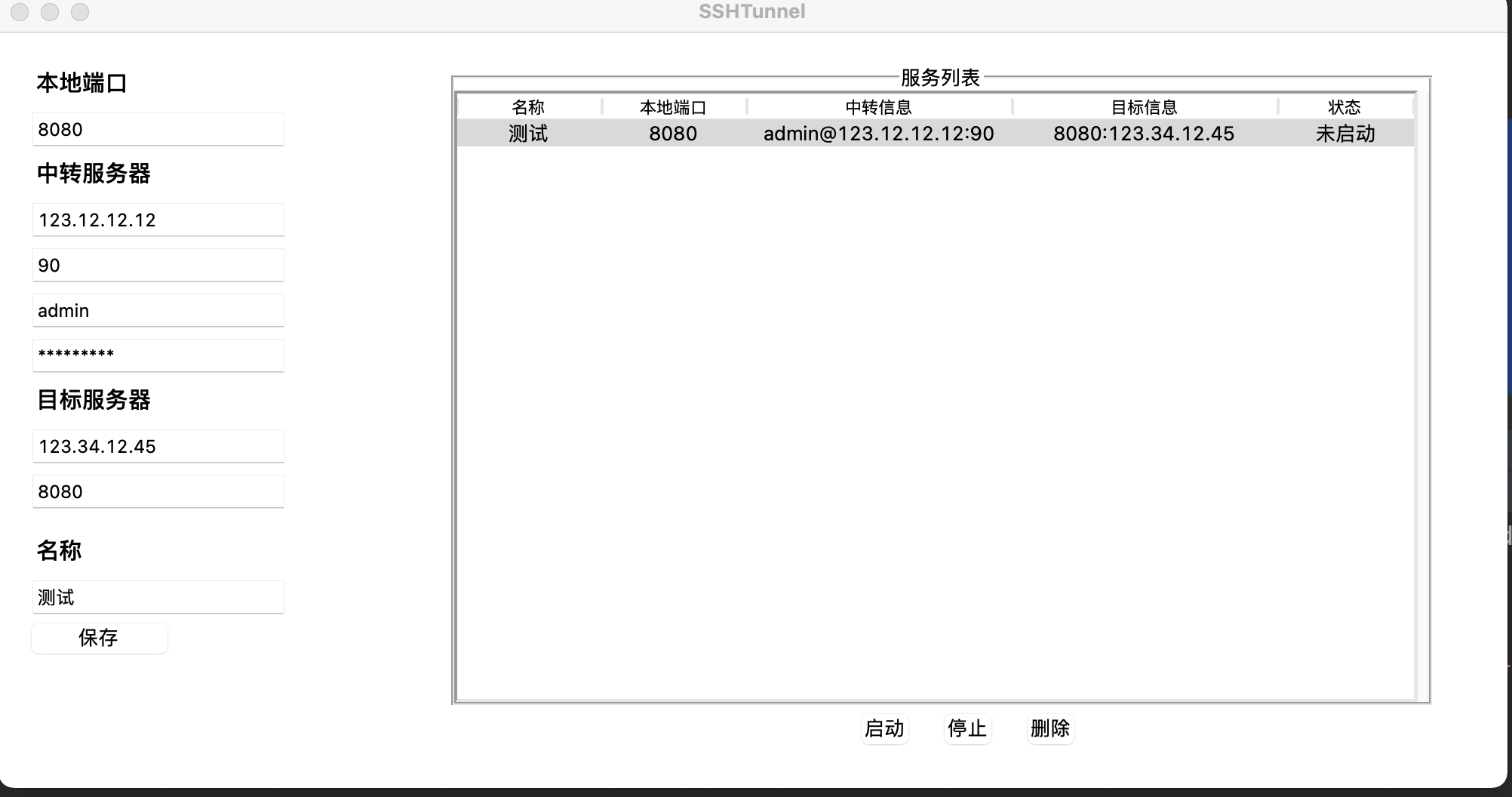开发原因
MobaXterm
作为一个全能型终端神器,功能十分强大,我经常使用其中隧道功能,使用内部无法直接服务器,查询数据,一般来说,一个本地端口对于一个隧道,但是
MobaXterm
,免费版本最多只能建立三个隧道,比如,我需要一次查询统计,就会用到四个隧道的操作,就非常不方便,需要调整一个隧道,于是,便用python写了多隧道的客户端

效果图

界面使用
tkinter
实现,左边是输入隧道的信息,右边为历史列表,
源码分析
构建隧道
def operate_sshtunnel(tunnel_info):
try:
tunnel = SSHTunnelForwarder(
(tunnel_info.ssh_ip, int(tunnel_info.ssh_port)),
ssh_username=tunnel_info.ssh_username,
ssh_password=tunnel_info.ssh_password,
remote_bind_address=(tunnel_info.remote_ip, int(tunnel_info.remote_port)),
local_bind_address=('127.0.0.1', int(tunnel_info.localhost_port))
)
return tunnel
except Exception as e:
print(e.args[0])
messagebox.showinfo(title='连接异常', message=e.args[0])
return
这段代码就是整个功能的核心代码,使用
SSHTunnelForwarder
模块的
sshtunnel
构建隧道,由于我只需要一个本地端口访问远程远程服务器的功能,默认本地端口固定为
127.0.0.1
初始化加载
def read_json():
if os.path.exists('tunnel_data.json'):
with open('tunnel_data.json', 'r', encoding='utf-8') as load_f:
data = load_f.read()
if len(data) > 0:
json_str = cryptocode.decrypt(data, "EjdeB55cvQMN2WHf")
return json.loads(json_str)
else:
return
def load_config():
load_arr = read_json()
if load_arr is not None:
for tunnel_info_json in load_arr:
tunnel_info = tunnel_info_class()
tunnel_info.localhost_port = tunnel_info_json['localhost_port']
tunnel_info.ssh_ip = tunnel_info_json['ssh_ip']
tunnel_info.ssh_port = tunnel_info_json['ssh_port']
tunnel_info.ssh_username = tunnel_info_json['ssh_username']
tunnel_info.ssh_password = cryptocode.decrypt(tunnel_info_json['ssh_password'], "F1jgEg1arVyxmUqC")
tunnel_info.remote_ip = tunnel_info_json['remote_ip']
tunnel_info.remote_port = tunnel_info_json['remote_port']
tunnel_info.tunnel_name = tunnel_info_json['tunnel_name']
tree_id = insert_tree_view(tunnel_info, "未启动")
tunnel_infos.update({tree_id: tunnel_info})
read_json
是读取历史记录,其中使用
cryptocode
模版对明文的
json
进行加密,并且对
ssh_password
进行再加密
开始服务
def start_tunnel():
iid = treeview.selection()
if len(iid) > 0:
if iid not in tunnel_infos_start.keys():
tunnel_info = tunnel_infos[iid[0]]
tunnel = ssl_tunnel.operate_sshtunnel(tunnel_info)
if tunnel is not None:
try:
tunnel.start()
tunnel_infos_start.update({iid[0]: tunnel})
update_tree_view(iid[0], tunnel_info, "启动")
pass
except Exception as e:
messagebox.showinfo(title='连接异常', message=e.args[0])
else:
messagebox.showinfo(title='选择异常', message="未选择列表")
tunnel_infos
为报存的隧道信息字典,
tunnel_infos_start
为报存的已经启动的隧道字典,先获取点击到的行的ID,然后查询是否在已启动的字典中,如果不存在则,启动隧道,同时更新到
tunnel_infos_start
中
停止服务
def stop_tunnel():
iid = treeview.selection()
if len(iid) > 0:
if iid[0] in tunnel_infos_start.keys():
tunnel_info = tunnel_infos[iid[0]]
tunnel = tunnel_infos_start[iid[0]]
if tunnel is not None:
try:
tunnel.stop()
tunnel_infos_start.pop(iid[0])
update_tree_view(iid[0], tunnel_info, "未启动")
pass
except Exception as e:
messagebox.showinfo(title='连接异常', message=e.args[0])
else:
messagebox.showinfo(title='选择异常', message="未选择列表")
这段代码操作和启动相反,则是从停止掉服务,同时从
tunnel_infos_start
中移除掉该隧道
移除服务
def remove_tunnel():
iid = treeview.selection()
if len(iid) > 0:
if iid[0] in tunnel_infos_start.keys():
stop_tunnel()
## 从列表删除
treeview.delete(iid)
tunnel_infos.pop(iid[0])
write_json()
else:
messagebox.showinfo(title='选择异常', message="未选择列表")
移除服务的时候,会判断
ID
在
tunnel_infos_start
是否存在,存在则表明当前删除的隧道还在启动中,则停止这个服务,同时从
tunnel_infos
移除这配置,更新
tunnel_data.json
文件
不足之处
虽然这个简单的工具可以满足超过多个隧道的使用,但是每次报存的时候,都要更新
tunnel_data.json
文件,如果隧道比较多,加载比较费时间;同时由于设计界面的时候,考虑比较简单,并不支持修改的功能,只能删除错误的记录,然后重新报存
源码地址